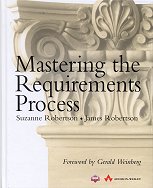Many organizations appear willing to spend huge amounts on fixing and altering badly specified software, but seem unwilling to invest a much smaller amount to get the requirements right in the first place.
This is a book for those who want to get the right requirements.
Mastering the Requirements Process sets out an industry-tested process for gathering and verifying requirements. It provides the techniques and insights for discovering precisely what the customer wants and needs.
The specification template in this book provides the basis for your own requirements specifications. It guides you to the correct specification content as each part of the process reveals different aspects of the product’s functionality and properties.
This book shows you how to make the requirement measurable and testable. By providing a measurement – a fit criterion – for each requirement, the requirements analyst can describe precisely what the customer wants, the designer can construct a product that exactly matches the requirement, and the tester can determine whether or not the final solution satisfies the requirement.
FEATURES
• The Volere requirements process – completely specified with a rigorous and detailed model.
• A specification template that can be used as the basis for your own requirements specifications.
• The requirements shell used for bringing rigor, tracability and completeness to requirements.
• Checklists to help identify stakeholders, users, non-functional requirements and more.
• Trawling techniques for eliciting requirements.
• How to exploit use cases to determine the best product to build.
• Reusing requirements and requirements patterns.
• Examples showing how the techniques and templates are applied real-world situations.
• Accessible style, fully cross-referenced, numerous diagrams.
